Reliability improvement of gas discharge tube by suppressing the formation of shortcircuit pathways
Lingyun CHENG(程凌云) ,Nianwen XIANG(向念文),2,*,Kejie LI(李科杰),*,Weijiang CHEN (陈维江), Kai BIAN (边凯), Jin YANG (阳晋),Zongqi XU (徐宗奇), Congying HAN (韩聪颖),Hongyang GU (古宏阳) and Chun YANG (杨纯)
1 Heifei University of Technology, Hefei 230009, People’s Republic of China
2Institute of Energy, Hefei Comprehensive National Science Center, Hefei 230031, People’s Republic of China
3 State Grid Corporation of China, Beijing 100031, People’s Republic of China
4 Beijing National Railway Research & Design Institute of Signal & Communication Group Co., Ltd.,Beijing 100070, People’s Republic of China
Abstract After cumulative discharge of gas discharge tube (GDT), it is easy to form a short circuit pathway between the two electrodes, which increases the failure risk and causes severe influences on the protected object.To reduce the failure risk of GDT and improve cumulative discharge times before failure,this work aims to suppress the formation of two short-circuit pathways by optimizing the tube wall structure, the electrode materials and the electrode structure.A total of five improved GDT samples are designed by focusing on the insulation resistance change that occurs after the improvement;then,by combining these designs with the microscopic morphology changes inside the cavity and the differences in deposition composition,the reasons for the differences in the GDT failure risk are also analyzed.The experimental results show that compared with GDT of traditional structure and material, the method of adding grooves at both ends of the tube wall can effectively block the deposition pathway of the tube wall, and the cumulative discharge time before device failure is increased by 149%.On this basis,when the iron-nickel electrode is replaced with a tungsten-copper electrode,the difference in the electrode’s surface splash characteristics further extends the discharge time before failure by 183%.In addition,when compared with the traditional electrode structure,the method of adding an annular structure at the electrode edge to block the splashing pathway for the particles on the electrode surface shows no positive effect,and the cumulative discharge time before the failure of the two structures is reduced by 22.8%and 49.7%,respectively.Among these improved structures, the samples with grooves at both ends of the tube wall and tungsten-copper as their electrode material have the lowest failure risk.
Keywords:gas discharge tube,short-circuit failure,tube wall groove,tungsten-copper electrode,failure risk
1.Introduction
Gas discharge tubes (GDT) play an important role in surge protection applications.This device offers the advantages of a simple structure, a strong flow capacity,high charge transfer,zero leakage currents,and high-frequency pass characteristics[1, 2].When the protection terminal voltage is lower than its nominal breakdown voltage,the GDT is in a high-impedance state.Under the action of transient overvoltage, the inert gas inside the GDT breaks down to form a plasma channel,which short-circuits the system, thus providing an energy release path to the ground to protect the system [3–6].However,engineering operational experience indicates that the insulation performance of a GDT generally declines after cumulative discharges, thus reducing the protection level provided and eventually nullifying the protection altogether.To make this situation worse,the protected equipment and system may then be short-circuited by the failed GDT rather than by a surge, thus changing the ‘protection’ into a severe threat to the safety of both equipment and personnel.This is the main reason why GDTs are rarely used in high-speed rail, national defense and other fields that require high stability and reliability.Therefore, it is essential to take measures to improve various aspects of the GDT to reduce the failure risk,so as to reduce the possibility of damage to the protected equipment and involved systems caused by its short-circuit failure.
There is various evidence to the fact that the improvement of GDT in terms of materials and structure can effectively improve the performance of the device.From the perspective of electrode material, Suzuki designed a singlewalled carbon nanotube (SWNT) electrode GDT, in which the breakdown voltage stability was 4–20 times higher than that of an ordinary commercial GDT[7–10],although its cost was relatively high.Rosen found that the surface material of the GDT electrode is not easy to form splashes after annealing, but this research mainly focuses on the early electrical characteristics [11].It also benefits a lot from the outcomes from cumulative discharges in gas, since the arc and erosion characteristics of spark gap switches have many similarities with GDT.Donaldson conducted a systematic study on the erosion of the spark gap (composed of two electrodes and an air gap), revealing the influence of electrode materials on the erosion process.He pointed out that the arc resistance of tungsten alloy is better than that of copper alloy,molybdenum and copper [12].References [13–15] conducted a comprehensive study on the erosion characteristics of tungsten-copper alloy electrodes.From the perspective of structure,researchers have studied the effects of the discharge tube’s electrode gap and electrode structure on the breakdown voltage, the response time, the current capacity, and other discharge tube characteristics [16–19].In the field of spark gap switches,Gӧrtler and Heo covered the SiC material for its high thermal conductivity and melting point on the surface of the basic electrode to form an approximate double-layer electrode in order to reduce electrode surface erosion[20,21].Li proposed the design of the ring electrode to improve the service life of the electrode in resistance spot welding [22].References [23–25] established erosion models and splash visualization models, which support the design and improvement of GDT structures.The researchers described above have achieved useful results in their efforts to improve GDTs.In summary,the existing research focuses on the early working characteristics and lacks the research on the longterm operation capacity and failure risk of GDT under severe operating conditions.In addition, related electrode materials and structural improvement methods in spark gap switches can try to learn from the electrode design of GDT.
2.Experimental setup and method
After cumulative discharges occur in GDTs, two ‘pathways’forming modes occur that are related to the short-circuit failure: the connections between the tube wall deposits and the connections among the flocs located between the electrodes, which both lead to insulation performance deterioration and increase the failure risk.In order to quantitatively characterize the failure risk of GDT, according to the ITU standard (ITU-T K.12) [27], samples with an insulation resistance of less than 1 GΩ are considered to enter the shortcircuit failure mode.We take the cumulative number of discharges when entering the failure mode as an important feature for evaluating the risk of failure.We, therefore, built a cumulative discharge experiment platform with 10 discharge channels, as illustrated in figure 1.In accordance with the[27], DC spark-over voltage experiments were conducted, in which the voltage rise rate applied at both ends of each sample was 100 V s-1,and the discharge frequency was 1 Hz.The experiments lasted for 14 h every day, involving approximately 50, 400±1500 discharges.At the end of the experiment each day,the insulation resistance and breakdown voltage of the sample were measured.This process was repeated until that sample failed.During the experiments,the discharge status of the GDT was monitored in real time, and the electrical characteristics of each of the failed samples were measured within 1 min.
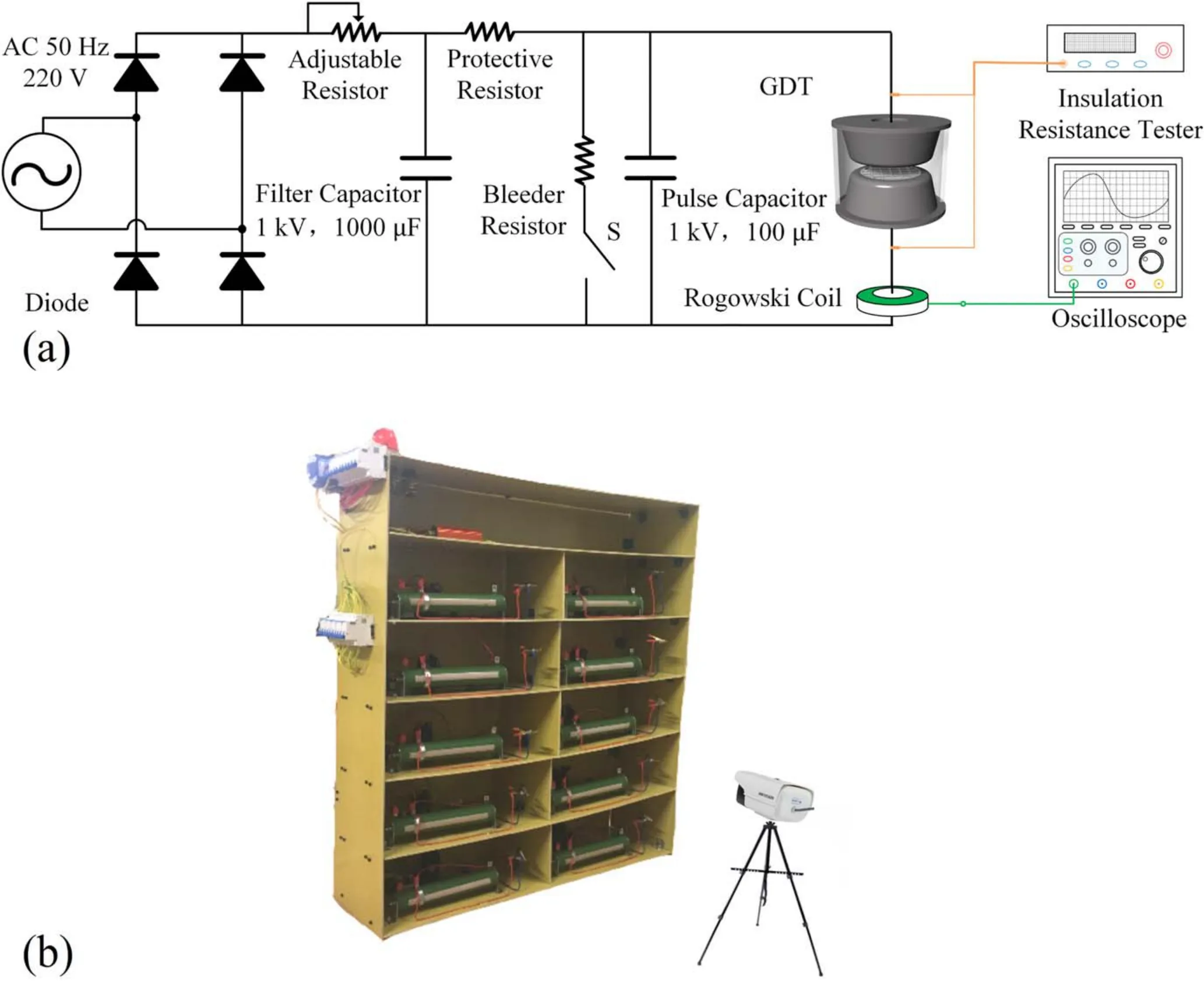
Figure 1.Cumulative discharge experiment platform.(a) Schematic of experimental platform, (b) experiment platform.
Six types of GDT were designed and produced in this work, including one prototype GDT and five types of improved GDT.The external dimensions of each self-made GDT were φ12 mm×6 mm, the tube wall was made from a ceramic material, and the interior was filled with argon and neon in a mixing ratio of 4:1.The barometric pressure is maintained at 53 kPa by an electronic air pressure control device with an accuracy of 0.1 kPa.The nominal voltage of the tube was 90 V, and the insulation resistance was no less than 100 GΩ initially.The typical breakdown voltage and discharge current waveforms in the experiment were shown in figure 2,where the peak current range was 355–390 A and the discharge pulse width was approximately 70 μs.The breakdown voltage and discharge current were measured by a high voltage probe (Tektronix P6015A) and Rogowski coil(model 110,Pearson)respectively, the oscilloscope used was the Yokogawa DLM3054.The impulse breakdown voltage was collected by the Vss-Ⅲ1 kV μs-1tester produced by Hubei Hanguang Co., Ltd The insulation resistance was measured using the insulation resistance tester produced by Changzhou Yangzi Electronics.After the cumulative discharges, the Nordson XD7500VR X-ray inspection machine was used to perform X-ray observations in the device cavity.The electrode and tube wall morphologies and compositions were detected using a Carl Zeiss Gemini500 thermal field emission scanning electron microscope and a Keyence 3D laser microscope.
3.GDT improvement and analysis
3.1.Prototype GDT
In accordance with the commonly used electrode materials and structures of commercial GDTs, we constructed a prototype GDT using an iron-nickel alloy (Fe-Ni, 42% mass fraction of Fe) as the electrode material; hereinafter, this device is referred to as the A-type GDT and is shown in figure 3.
In the cycle of cumulative discharge,the changes of GDT electrical characteristics such as insulation resistance,impulse breakdown voltage, DC breakdown voltage were concerned.In addition, the GDT cavity was observed vertically using x-rays without destroying the GDT structure.In order to compare and analyze the improved GDTs, we assessed the morphology of the electrode, and the morphology and roughness of the corresponding tube wall.The roughness of the samples studied in this paper is controlled to be within the range from 20 μm to 25 μm before the cumulative discharge experiment is performed.

Figure 4.A-type GDT insulation resistance changes in the cumulative discharge cycle.The number of prototype GDT and improved GDT samples is 10, labeled 1#–10#, respectively, the same below.
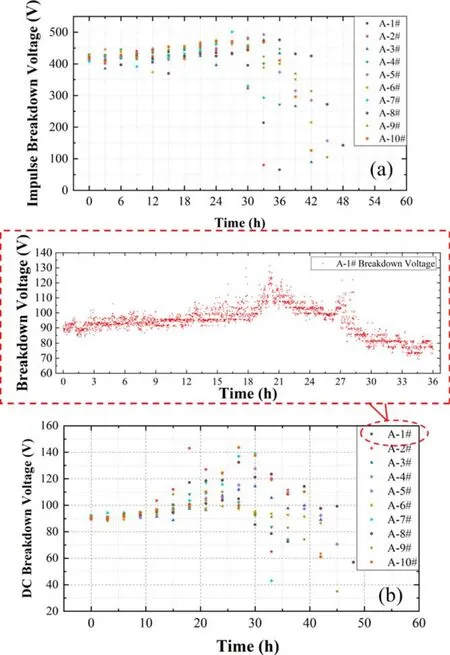
Figure 5.A-type GDT impulse breakdown voltage and DC breakdown voltage change.(a) Impulse breakdown voltage change in the cumulative discharge cycle.(b)DC breakdown voltage change in the cumulative discharge cycle, and the detailed change of the breakdown voltage of A-1# GDT.
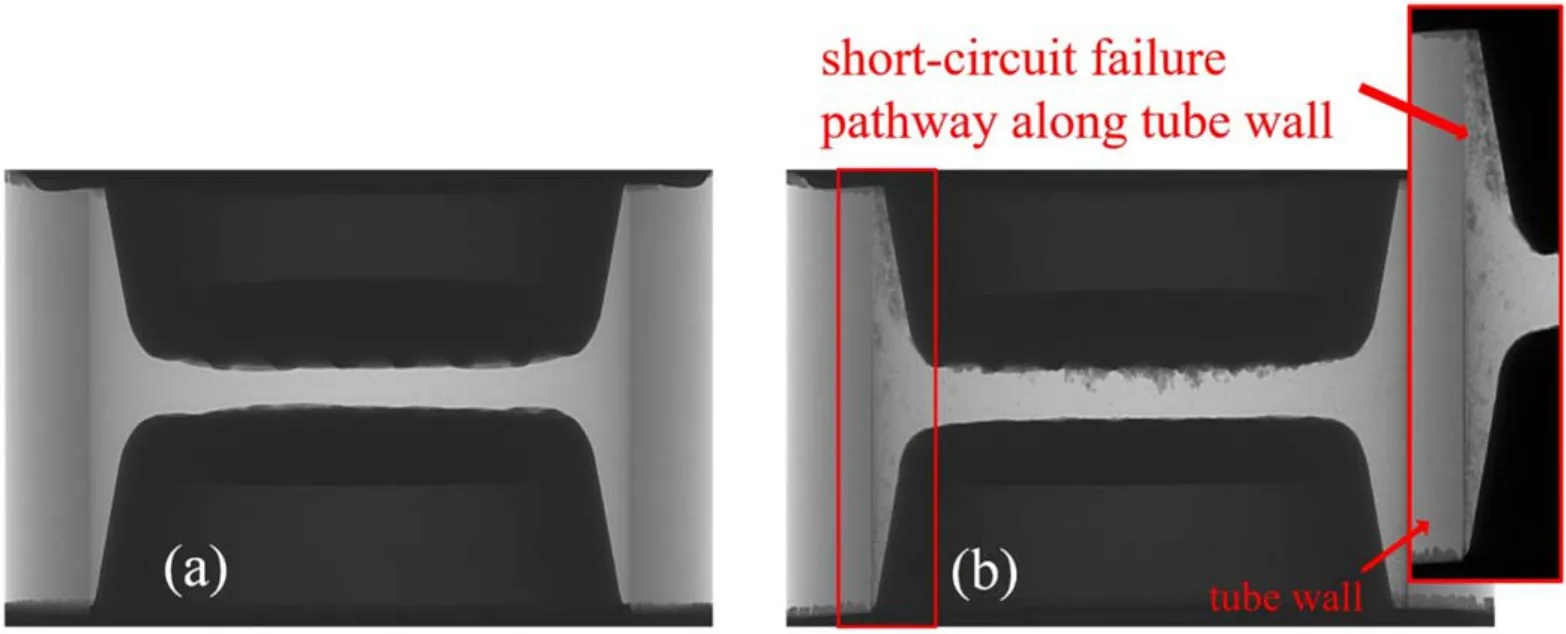
Figure 6.X-ray image comparison before and after A-type GDT experiment.(a) Before the experiment.(b) After the experiment.
Based on the setup described in section 2,the cumulative discharge experiment was performed.The experimental results show that the average discharge time of A-type GDT is about 145,000.The insulation resistance of the GDT was able to maintain at the GΩ level during the first 90% of its cumulative discharge cycle.However, during the last 10% of the cycle of cumulative discharge, the insulation resistance substantially fell by multiple orders of magnitude, as illustrated in figure 4.The impulse breakdown voltage and DC breakdown voltage are stable in the early stage of the cumulative discharge cycle, rising in the middle stage and declining at the end of the cycle, as shown in figure 5.However,there is a significant difference in the magnitude of change of the two breakdown voltages.Compared with the initial value,the average value of impulse breakdown voltage increased by 11.5% in the middle stage and decreased by 63.3%in the end stage.The average value of DC breakdown voltage increased by 35.7% in the middle period and decreased by 28.1% in the end period.It is worth noting that the above three indexes show an obvious downward trend at the end of cumulative discharge.
Generally, insulation resistance, impulse and DC breakdown voltage are important indicators of GDT performance.However, in this study, we pay more attention to the reduction of GDT short-circuit failure risk than the use characteristics.It is worth noting that the insulation resistance is directly related to the short-circuit failure, and has a clear termination criterion and distinguishing effect, so we choose it as the reliability criterion in the following research.The breakdown voltage is more related to the service life of the GDT, and compared with the insulation resistance, it has disadvantages such as large dispersion and large fluctuations.
The change of the internal structure of the cavity before and after discharge was observed by X-ray along the longitudinal axis of GDT, as shown in figure 6.The X-ray observation results indicate that splash deposition occurred on the side of the tube wall of the failed A-type GDT, thus forming a short-circuit pathway along the tube wall.Along the axial direction, the tube wall deposits are thick in the middle but thin at the ends.The micromorphology observation results show that the surface characteristics of the A-type GDT electrode include large volume,high density,and general overlapping of the particles.The maximum diameter of the particles is 382 μm, and the electrode’s surface roughness is 112.490 μm, as shown in figure 7(a).A large number of particles were also deposited uniformly on the tube wall surface with high density, with the maximum diameter of these deposited particles reaching 59 μm,as illustrated in figure 7(b).
Based on the phenomena described above, it can be concluded that the splash particles that formed on the electrode surface are the main factors that lead to the formation of short-circuit pathway on the tube wall.Therefore, how to reduce the splashing efficiency on the electrode surface and suppress the formation of the deposition pathways on the tube wall are the key points to reduce the failure risk of GDTs.To solve the problems illustrated above, we improved the GDT from the perspectives of the tube wall structure,the electrode materials and the electrode structure.
And the second brother said to himself as he listened, Certainly he has managed very badly, but I should like to see if I can t do better, and win the princess for my own self
3.2.Improvement of tube wall structure
To suppress the formation of the short-circuit pathways on the tube wall,it is appropriate to machine annular grooves into both ends of the tube wall to provide the lowest possible deposition efficiency.Using the A-type GDT as a basis,the two ends of the tube wall are slotted to obtain a GDT with an improved tube wall structure, which is referred to hereinafter as the B-type GDT and is illustrated in figure 8.The results of the cumulative discharge experiment indicate that the average cumulative discharge of the B-type GDT is 362,000 times, which is approximately 1.49 times longer than that of the A-type GDT.The variation in the insulation resistance of the device is shown in figure 9,and the change trend observed is basically the same as that for the A-type GDT.These results demonstrate that this tube wall improvement method is effective.
The X-ray vertical axis observation results shown in figure 10 indicate that the short-circuit failure of the B-type GDT is mainly caused by the conduction properties of the tube wall deposits.When compared with the tube wall before the experiment, an obvious deposit connection phenomenon is observed on the side of the GDT tube wall after the experiment.Large numbers of particles accumulate in the grooves at both ends of the tube wall on the same side.As expected, this behavior is the key phenomenon that must be addressed to reduce the failure risk of the B-type GDT.The splashes formed by the arcs are considered to be distributed largely along the axial direction, as shown in figure 11(a).After grooving is performed at both ends of the tube wall,the inner cavity of the groove can then contain the proportion of the splashes that would otherwise have been deposited on both ends of the tube wall.The groove thus inhibits axial growth of the tube wall splash particles, thereby reducing the efficiency of the tube wall deposit connections, as illustrated in figure 11(b).
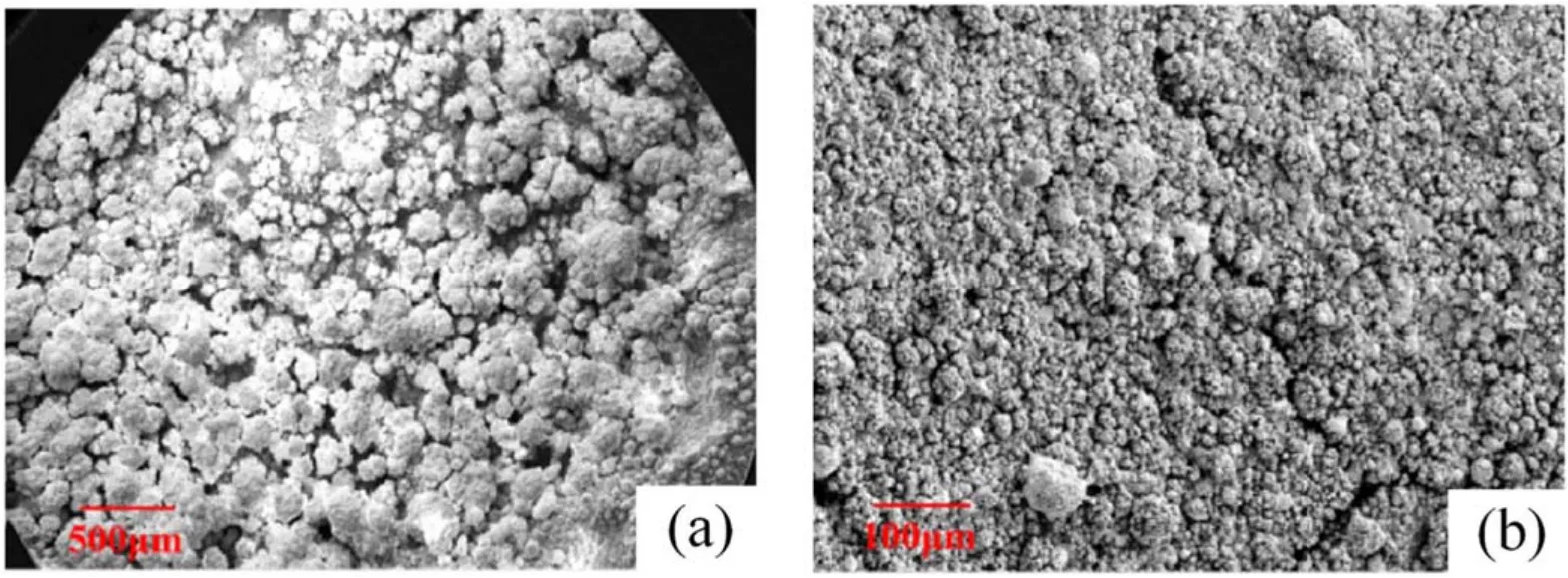
Figure 7.Micromorphology of electrode and tube wall after accumulative discharge of A-type GDT.(a) Electrode.(b) Tube wall.
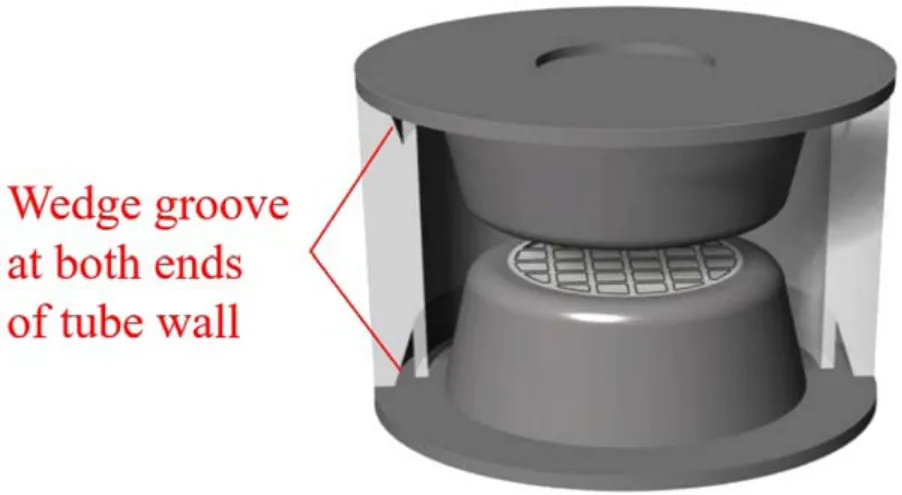
Figure 8.Improved GDT of tube wall.(B-type GDT).
In addition,when the measurements above are combined with the scanning electron microscope observation results,the B-type GDT electrode surface is found to suffer from melting over a large area, as shown in figure 12(a).The main reason for this phenomenon is that the electrode, in this case, has withstood more discharges than the A-type GDT.Part of the area that was not covered by the molten metal shows an accumulation phenomenon similar to that on the surface of the A-type GDT electrode formed by the early splashing behavior,thus directly illustrating that the molten state of the electrode surface was generated by the larger number of discharges.The resulting surface roughness of this molten electrode is 53.161 μm,which is lower than that of the A-type GDT.The splash particle deposition observed on the tube wall surface is similar to that on the A-type GDT, and the maximum diameter of the deposited particles is approximately 52 μm,as indicated in figure 12(b).Because the ironnickel electrode molten pool splashing deposits caused by the arc are mostly composed of large particles at small splash angles, the short-circuit failure pathway is mainly connected via the tube wall deposits.The difficulty of forming the connecting pathway among the tube wall deposits determines the rate of GDT insulation degradation.Therefore, the cumulative discharge time of the GDT with the annular grooves at both ends of the tube wall is longer than that of the GDT without these grooves.
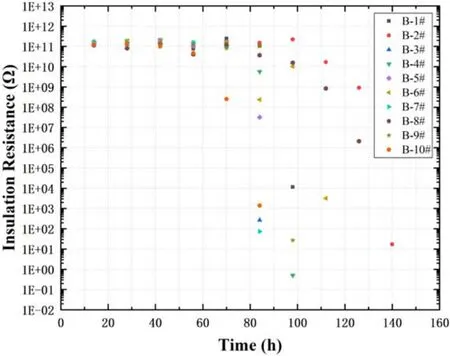
Figure 9.B-type GDT insulation resistance changes in the cumulative discharge cycle.
However, with increasing discharge time, the electrode erosion becomes more serious, and the main pathway for short-circuit failure then changes from the tube wall to the electrodes.As a result, we make a targeted improvement based on this scenario to the electrode material in the following part.
3.3.Improvement of electrode material
We refer to prior experience of the electrode switch materials used in the spark discharge field to improve the GDT electrode[28,29].Because the tungsten-copper alloy shows good thermal stability, the existing iron-nickel electrode is replaced with a tungsten-copper electrode (W-Cu, 30% mass fraction of Cu) of the same size based on the electrode of the B-type GDT,which is then designated the C-type GDT,as illustrated in figure 13(a).In addition,based on considerations from an economic perspective,we designed another GDT that only uses the expensive tungstencopper alloy on the electrode surface and uses the iron-nickel alloy as a substrate; this device is hereinafter referred to as the D-type GDT.The D-type GDT structure is half tungsten-copper and half iron-nickel,as illustrated in figure 13(b).The gray part of the structure is the iron-nickel substrate, and its height is half of that of the prototype electrode.The orange part of the structure is the tungsten-copper flat cylindrical electrode,which has the same thickness as the substrate.The ring groove design is also included at both ends of the tube wall.

Figure 10.X-ray image comparison before and after B-type GDT experiment.(a) Before the experiment.(b) After the experiment.

Figure 11.Schematic diagram of grooved tube wall deposition.(a)Schematic diagram of normal tube wall deposition.(b)Schematic diagram of deposition of grooves at both ends of the tube.
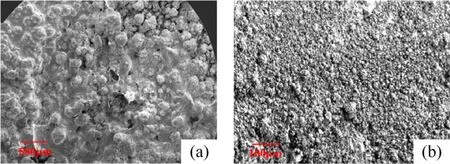
Figure 12.Micromorphology of electrode and tube wall after accumulative discharge of B-type GDT.(a) Electrode.(b) Tube wall.
After the cumulative discharge experiment, the average discharge of the C-type GDT is 1.023 million times,which is approximately 1.83 times longer than that of the B-type GDT.The change trend in the insulation resistance is basically the same as that observed in the B-type GDT, as shown in figure 14(a).The results show that the improvement of electrode material significantly reduces the failure risk of GDT.

Figure 13.Improvement of gas discharge tube with electrode material.(a) C-type.(b) D-type.
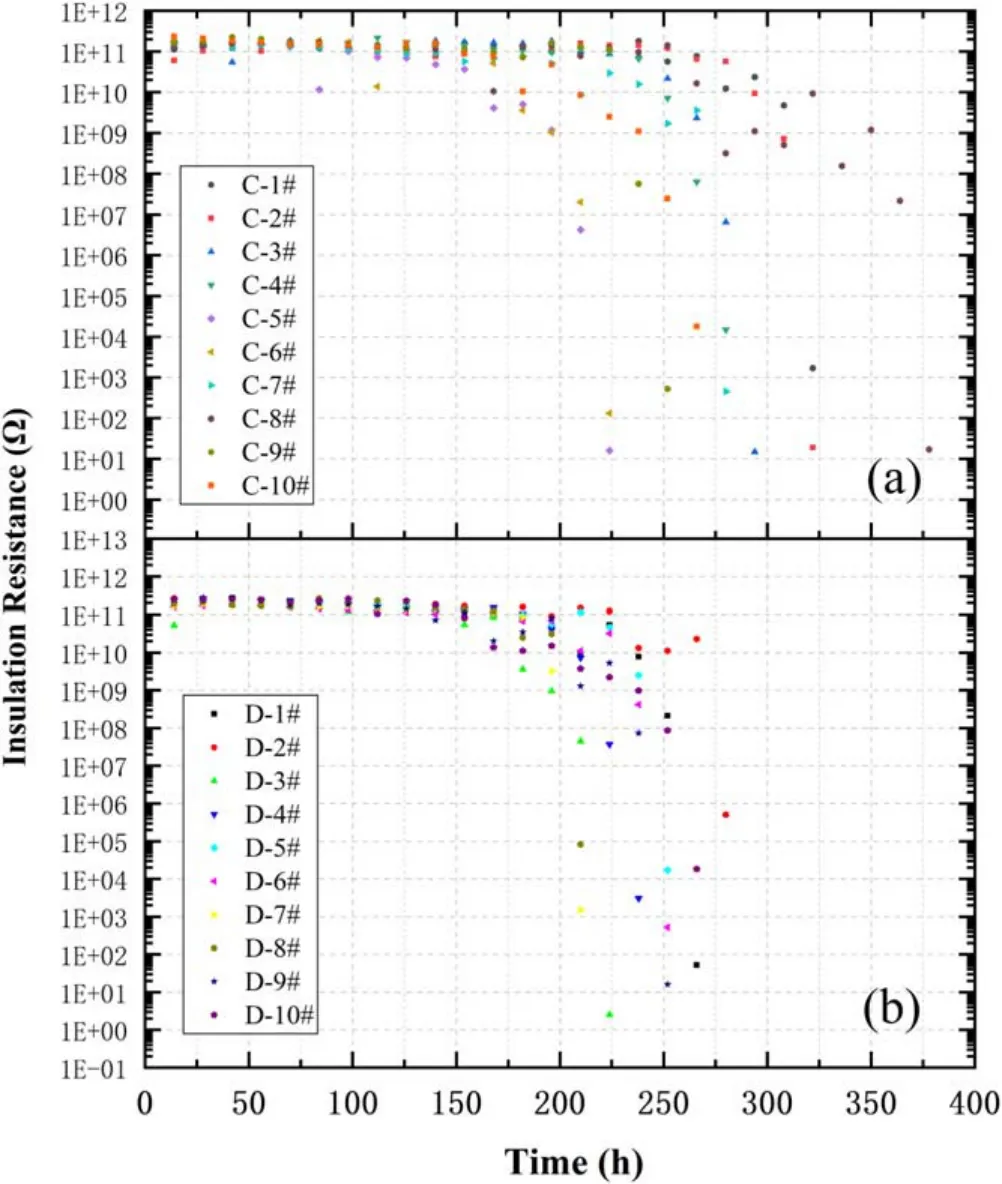
Figure 14.Two types of GDT improved from electrode material.(a)C-type GDT.(b) D-type GDT.
The X-ray observation results shown in figure 15 indicate that the short-circuit failure pathway of the C-type GDT is formed by the connection of the growths between the electrodes, but this growth behavior is different from that of the flocs between the electrodes described previously in the[26].When these observations are combined with the comparison of the micromorphology shown in figure 16(a), the C-type GDT electrode surface is flatter than the corresponding surfaces of both the A-type and B-type GDTs, and only local particles accumulate at the lower right side, thus indicating that the arc is largely concentrated in this area.The maximum diameter of the particles observed in this area is 220 μm,and the electrode surface roughness is 42.424 μm.The corresponding tube wall is also relatively flat, with only small amounts of metal deposits being detected by energy-dispersive spectrometry (EDS), and the maximum deposited metal particle diameter is only 9 μm, as shown in figure 16(b).
Comparison of the phenomena before and after the experiments allows the following judgments to be made with regard to the accumulation process between the electrodes.We speculate that, during the cumulative discharge process,the copper on the tungsten-copper electrode surface becomes molten after heating because it has a lower melting point,and this copper thus forms the splashes under the action of the arc.As illustrated in figure 17,on one hand,with the consumption of the copper from the electrode surface, the remaining molten copper becomes concentrated within the tungsten framework, and the tungsten framework then affects the copper’s normal splash pathway, causing the small splash angle pathway to be blocked, and the molten metal can thus only form an effective splash along the axial direction.On the other hand, because of the large splash angle involved, the splashes tend to accumulate on the electrode surface near the arc.The bumps that are formed by this accumulation then cause local electric field distortion, which makes it easier to form discharges and the accompanying splashes.This form of accumulation thus results in an axial accumulation of the splashes between the electrodes, with little deposition occurring on the tube wall.In addition, because of the characteristics of the small deposited particles and the limited effective splashing range, the formation rate and structural stability properties of the accumulation growth channel between the electrodes are inferior to the corresponding properties of the tube wall deposition channel.

Figure 15.X-ray image comparison before and after C-type GDT experiment.(a) Before the experiment.(b) After the experiment.

Figure 16.Micro morphology of electrode and tube wall after accumulative discharge of C-type GDT.(a) Electrode.(b) Tube wall.
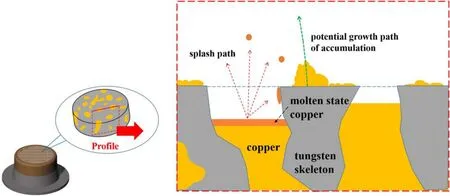
Figure 17.Schematic diagram of surface deposition of tungsten-copper alloy electrode.
For the difference of erosion degree and morphological characteristics between tungsten-copper electrode and ironnickel electrode after cumulative discharge, the reasons for the difference are analyzed from the macroscopic and microscopic perspectives of the material.From the macro perspective, the tungsten skeleton structure with a high melting point(melting point 3410°C)divides the copper with a low melting point(melting point 1083°C),which is difficult to form a large molten pool at the arc root, resulting in the reduction of splashing.The low melting point iron-nickel material (about 1430 °C) does not have the above characteristics.After overall heating, iron and nickel melt at the same time, forming a larger molten pool, resulting in large and more splashing particles.From the microscopic perspective, the grain size of different alloys will also affect the difference of erosion degree and morphology characteristics.Through metallographic analysis and auxiliary calculation,the tungsten-copper alloy grain used in the experiment is 3.82 μs, and the iron-nickel alloy grain is 18.21 μs.The lattice structure of tungsten-copper alloy with small grains will deform at the grain boundary,making the electron energy distribution in the grain and grain boundary different, so that there is a contact potential difference between adjacent grains and grain boundaries.Under the action of the external electric field, the electrons at the grain boundary on the cathode material surface are easier to escape than those in the grain,that is,the work function of electrons in the grain boundary is lower than that on the grain.Similarly, there are contact potential differences between adjacent grains and phase boundaries,and the electrons in the phase boundary are easier to escape than those in the grains.Therefore, for tungstencopper materials with small grains, the electric field at the phase boundary is greatly enhanced and becomes a new field induced point, which makes the cathode spots jump quickly on the surface of the cathode material.Therefore, the residence time of the arc in a certain area is reduced, that is, the local continuous erosion time is reduced.For iron nickel materials with relatively large grains, the potential difference between adjacent grains and grain boundaries is small, and the cathode spots jump slowly on the surface of cathode materials, resulting in the arc staying in a certain area for a long time, and the energy is concentrated and released in these areas.In addition, the difference in melting point leads to the difference of erosion degree and morphology between the two alloys.Therefore, the C-type GDT can withstand more arc discharges than the other GDTs and has a lower risk of failure.

Figure 18.X-ray image comparison before and after D-type GDT experiment.(a) Before the experiment.(b) After the experiment.
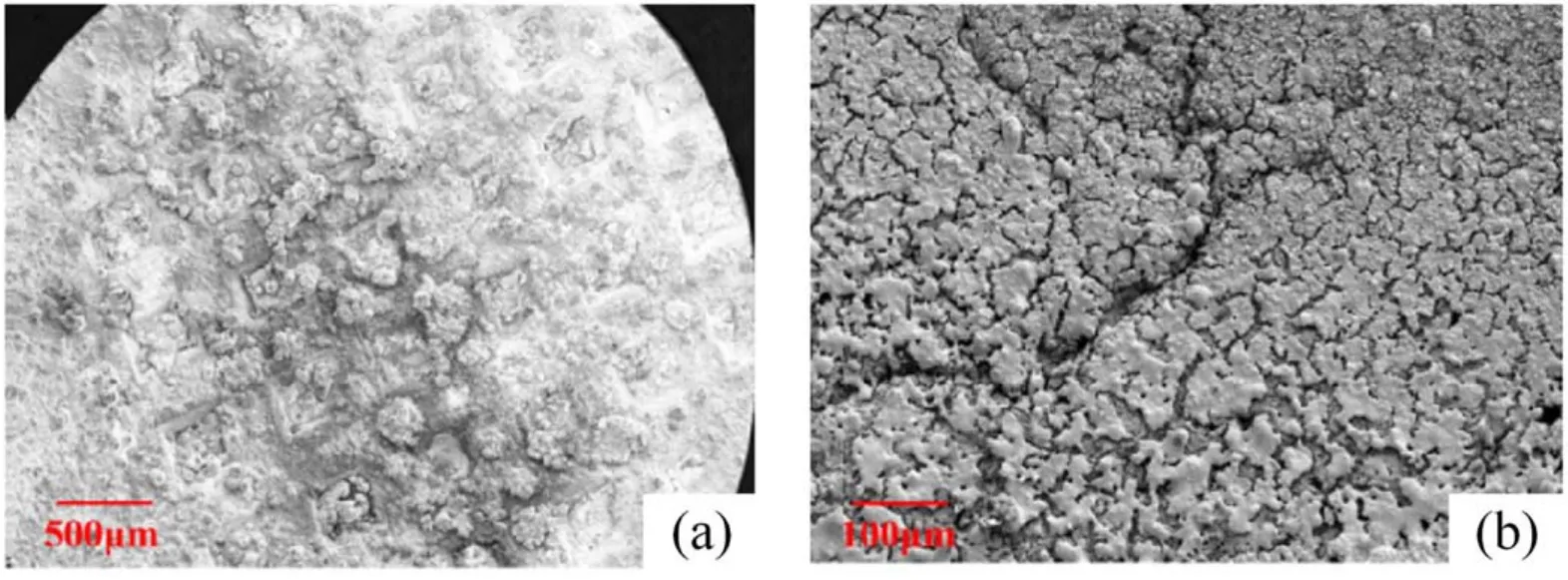
Figure 19.Micromorphology of electrode and tube wall after accumulative discharge of D-type GDT.(a) Electrode.(b) Tube wall.

Figure 20.Improvement of gas discharge tube with electrode structure.(a) E-type.(b) F-type.
Because the cost of the tungsten-copper alloy is several times higher than that of the iron-nickel alloy,and because the electrode splashing only occurs within the surface layer, we also designed a D-type GDT with a surface electrode composed of the tungsten-copper alloy and a substrate composed of the iron-nickel alloy.For this D-type GDT,the cumulative discharge experiments show that the average discharge time of the D-type GDT is 882,000.When compared with the C-type GDT with its improved tube wall and electrode structures, the discharge time of the D-type GDT is reduced by approximately 13.7%.The change trend observed for the insulation resistance of the D-type GDT is basically the same as that of the C-type GDT, as shown in figure 14(b).X-ray observations showed that the tungsten-copper electrode surface is relatively flat, without any obvious protrusions.The phenomenon of particle deposits connecting on the tube wall was observed, and the deposition on the tube wall at the cathode is more obvious.A comparison of the images before and after the cathode experiment indicates that the iron-nickel substrates have been partially consumed, as indicated by the red circles shown in figure 18.Comparison of the micromorphology and the composition analysis results shows that the D-type GDT’s electrode surface has lower particle accumulation when compared with that of the C-type device;the surface is also flatter and the number of accumulations on the electrode is lower.The maximum particle diameter is 210 μm and the electrode surface roughness is only 29.349 μm,as shown in figure 19(a).The splash deposits on the tube wall surface also showed a melted and expanded morphology,and the crack density was relatively high, as illustrated in figure 19(b).This molten substance is determined by EDS composition analysis to account for 80.4%of the atomic ratio of tungsten and copper, and 6.5% of that of iron and nickel.The degree of erosion of the D-type electrode is smaller than that in the A-type and B-type GDTs; the even part of the electrode area is smaller than that of the C-type GDT with the complete tungsten-copper electrode, which is due to the difference between the number of discharges.When considered in combination with the EDS results, it can be seen that the reason for the difference in the number of discharges that the device can withstand is that the metal vapor formed by the iron-nickel part of the electrode adheres to the tube wall and electrode surface in the high-temperature environment,which then accelerates the formation rate of the short-circuit pathway relative to that of the C-type GDT.
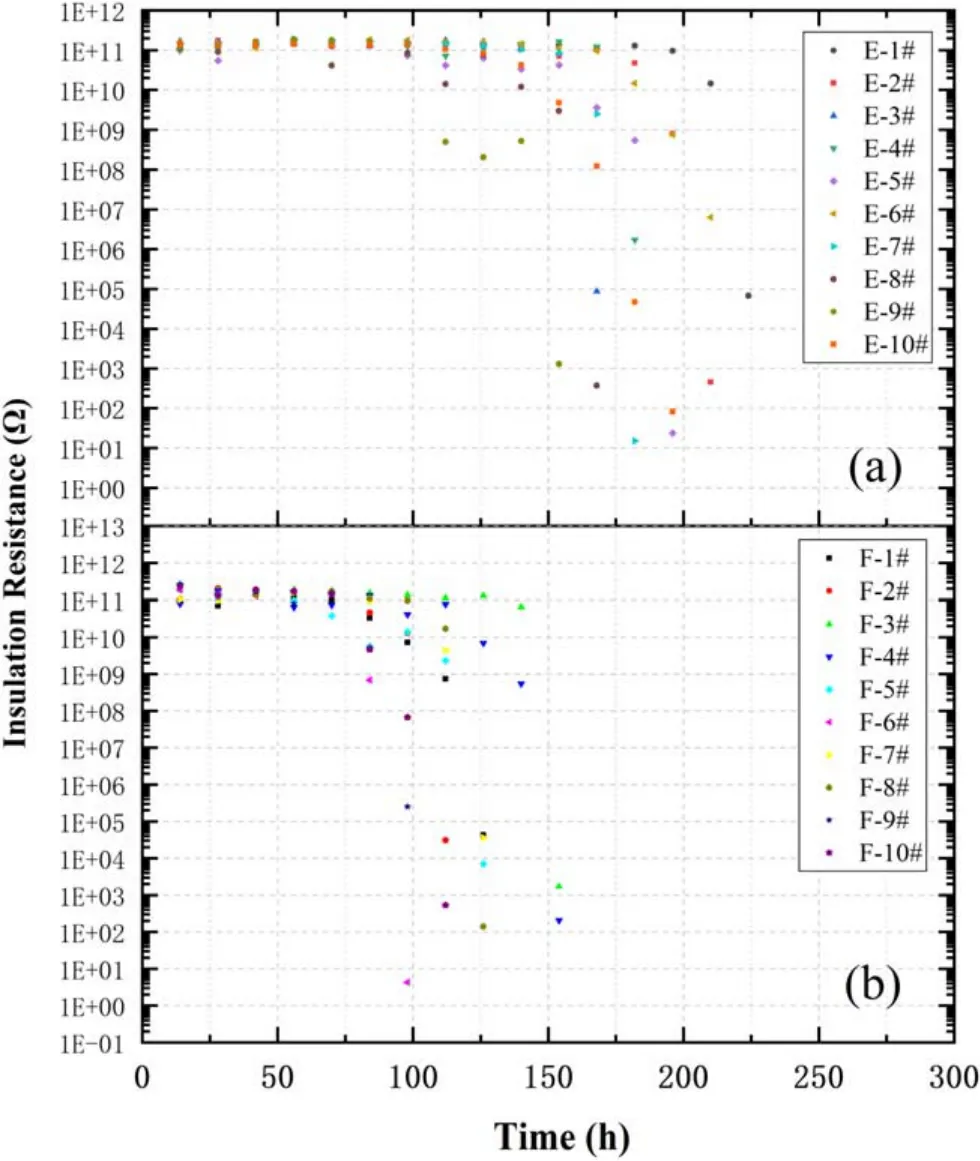
Figure 21.Two types of GDT improved from electrode structure.(a)E-type GDT.(b) F-type GDT.
3.4.Improvement of electrode structure
According to the splashing pathway of molten metal particles on the electrode surface and the result of tube wall deposition,we designed a ring structure at the edge of the electrode to suppress particles from depositing on the tube wall.Hereinafter,these structures are referred to as the E-type and F-type GDTs, as illustrated in figures 20(a) and (b), respectively.
In the E-type GDT, the gray part is the iron-nickel substrate, and the orange part comprises a tungsten-copper flat cylindrical electrode and a tungsten-copper ring electrode with the same thickness deposited on the iron-nickel substrate.In the F-type GDT,where the electrode design was considered from an economic perspective, a tungsten-copper ring electrode with the same thickness as the iron-nickel substrate layer is connected concentrically to the substrate.The tube walls of these two GDTs are also formed with the grooves described earlier.Cumulative discharge experiments showed that the average discharge time of the E-type GDT and the F-type GDT is 680,000 and 444,000, respectively.When compared with the C-type GDT with its improved tube wall and electrode designs, the cumulative discharge time of the E-type and F-type GDTs is reduced by approximately 33.5% and 56.6%, respectively.The change trends in the insulation resistance for the two GDTs are basically the same as that of the previous improved GDT, as illustrated in figure 21.
The X-ray observation results shown in figure 22 indicate that the tube wall of the E-type GDT shows a more obvious particle deposition phenomenon than the D-type GDT.At the same time, relatively numerous accumulations of metal particles can be seen at both ends of the tube wall, which is similar to the D-type GDT.Comparison of the micromorphology and the composition analyses show that the D-type GDT electrode surface has a small particle size and high particle density characteristics.The maximum particle diameter is 185 μm and its roughness is 50.466 μm,as shown in figure 23(a).This differs obviously from the morphology of the complete tungsten-copper electrode of the C-type GDT.On one hand,the differences between the surface phenomena may be caused by the differences between the thicknesses of the tungsten-copper part of the electrodes.The thickness of the tungsten-copper flat cylinder in the E-type electrode is only one-fourth of that of the C-type electrode and one-half of that of the D-type electrode.On the other hand,for the E-type structure, as the electron-emitting material that promotes ionization continues to be consumed from the surface of the flat cylindrical electrode, the arc gradually moves toward the tungsten-copper ring.When compared with the previous structures,the arc channel length is shortened,and the energy of the arc is reduced,thus resulting in the splash phenomenon finally showing the small and dense particle characteristics.In addition, based on the characteristics of the electrode structure, the molten pool splashing on the tungsten-copper ring electrode has a wider range of splashing angles when compared with that of the flat cylindrical electrode surface,which increases the splashed particle deposition rate on the tube wall, as illustrated in figure 24.The latter aspect is neglected in the design of this structure.Therefore,the discharge time of the E-type GDT is less than that of the C-type and D-type GDTs without the ring electrode structure.With regard to the tube wall in this case, the material deposited on its surface spreads out in a molten state, as shown in figure 23(b).This molten substance is determined by EDS composition analysis to account for 81.5% of the atomic ratio of tungsten and copper, and 0.47% of that of iron and nickel.The iron and nickel contents are lower than that in the D-type GDT,which also supports the proposed evaporation of the substrate metal of the D-type GDT during the cumulative discharge.

Figure 22.X-ray image comparison before and after E -type GDT experiment.(a) Before the experiment.(b) After the experiment.

Figure 23.Micromorphology of electrode and tube wall after accumulative discharge of E-type GDT.(a) Electrode.(b) Tube wall.
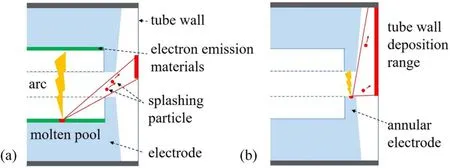
Figure 24.Schematic diagram of annular electrode splashing.(a)The early arc is formed on the surface of electrode with electron emission material,and the area of splashing on the tube wall is small.(b)With the consumption of electron emission materials on the electrode surface,the arc moves to the annular part of the electrode edge, and the splash range is relatively large.
In the F-type GDT,the middle area of the electrode surface is composed of the iron-nickel alloy.X-ray observations showed that both the electrode and the tube wall show an obvious particle deposition phenomenon, and this phenomenon is more obvious than that in the E-type GDT, as illustrated in figure 25.Comparison of the micromorphology and composition analysis shows that the F-type GDT electrode also has an obvious molten state connection phenomenon, as illustrated in figure 26(a).Most of the deposited particles are fused together to form a molten layer that covers almost the entire electrode surface, resulting in the largest particle size on the surface (although it cannot be characterized quantitatively),and the surface roughness is 44.865 μm.When compared with the A-type and B-type GDTs with the iron-nickel alloy on their electrode surfaces, the F-type GDT shows more serious erosion and the particles are in a molten state.This phenomenon is related to the fact that the tungstencopper ring on the electrode surface obstructs the splash pathway for the iron-nickel splashes.A proportion of the iron-nickel splashes with small splash angles is thus blocked and then continuously accumulates and solidifies in the molten state under the tungsten-copper ring at the electrode edge.In addition, the slowing of the tube wall deposition rate leads to the F-type GDT showing more discharge time than the A-type and B-type GDTs.When compared with the E-type GDT, the F-type GDT structure is essentially formed by the molten pool splashing on the iron-nickel alloy surface.Therefore,it can withstand fewer discharges than the structure formed by molten pool splashing on the tungsten-copper surface of the E-type GDT.On the tube wall,large numbers of particles are deposited relatively uniformly on the surface, similar to the phenomena on the A-type and B-type GDT tube walls.The maximum particle diameter is 375 μm, which is larger than that in the A-type and B-type cases, as shown in figure 26(b).The reason for this phenomenon is that the F-type GDT withstands more discharge time than the A-type and B-type GDTs.

Figure 25.X-ray image comparison before and after F-type GDT experiment.(a) Before the experiment.(b) After the experiment.
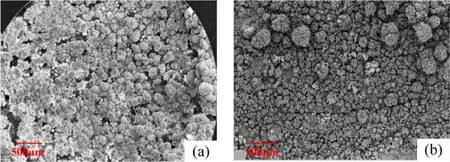
Figure 26.Micromorphology of electrode and tube wall after accumulative discharge of F-type GDT.(a) Electrode.(b) Tube wall.
4.Discussion
Among the six types of GDT presented above, the sample with the electrode structure made from tungsten-copper alloy with annular grooves at both ends of the tube wall (i.e., the C-type GDT)can withstand the maximum cumulative discharge time in case of insulation failure.Compared with the prototype GDT, the cumulative discharge time that the five improved GDTs can withstand is increased to varying degrees, as shown in figure 27.It means that several improved GDTs have achieved the purpose of reducing failure risk.Among the measures proposed in this work, the method in which annular grooves are slotted at both ends of the tube wall can reduce the efficiency of axial growth of the deposition on the tube wall effectively and reduce the risk of device failure when compared with that of the prototype GDT.On the basis that these annular grooves are included in the tube wall,the improvement provided by using the tungsten-copper alloy electrode to replace the ironnickel alloy electrode reduces the splashing efficiency of the particles on the electrode surface and thus further decrease the failure risk of the GDT.We also improved the material economics by only using tungsten-copper alloy in the surface electrode.This improvement does bring the problem that partial melting of the iron-nickel substrate accelerates the formation of the short-circuit pathway, which then leads to an increase in the failure risk when compared with the samples of the complete tungsten-copper alloy electrode.In addition, the proposed improvement of adding a ring edge to the electrode did not achieve the desired effect.The main reason is that in the later stage of cumulative discharge,large-scale splashes are formed on the edge of the ring,which increases the growth efficiency of the deposits on the tube wall.In the case where the same tube wall structure was used, the failure risk of GDTs with two different types of electrode structure increases to different degrees.The cause of the difference between the two devices failure risk indicates that the method of adding a ring at the edge of the electrode to block the splash path and thus reduce the deposition efficiency on the tube wall is ineffective.On the contrary, the splashing on the ring structure during the later stages of the cumulative discharge actually accelerates the deposition efficiency.
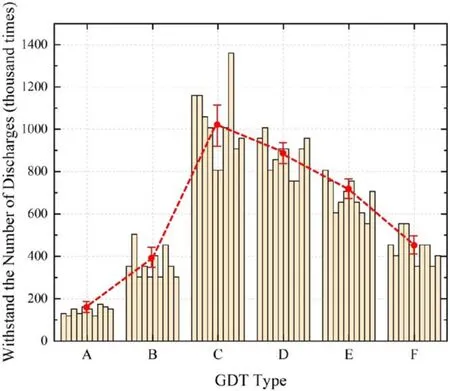
Figure 27.Comparison of withstand discharge times of various improved GDTs.
5.Conclusions
To reduce the failure risk of GDTs and increase the cumulative discharge time before failure, this work has proposed several improvements to the GDT from the perspectives of the tube wall structure, the electrode material, and the electrode structure, comparing the improvement effects that were realized, and then analyzed the reasons for the differences observed in the failure risk.
It was found that compared with the traditional GDT structure and materials, the proposed design in which annular grooves are used at both ends of the tube wall can effectively obstruct the deposition pathway on the tube wall, and the cumulative discharge time before device failure is increased by 149%.On this basis,after the conventional iron-nickel electrode was replaced with a tungsten-copper electrode, the difference in the electrode splash characteristics caused the short-circuit pathway to move from the tube wall to be located between the two electrodes.The low splash deposition efficiency between the electrodes and the instability of the pathway structure caused the further increase of discharge time before device failure by 183%.However, when the electrode surface layer is composed of the tungsten-copper alloy and the substrate is the iron-nickel alloy,the discharge time before GDT failure is 13.7% lower than that of a complete tungsten copper electrode.Furthermore, the addition of an annular structure at the electrode edge produced no positive effects on reduction of the deposition efficiency or decrease the failure risk of GDT.
Acknowledgments
This work is supported by National Natural Science Foundation of China (No.U1834204).
ORCID iDs
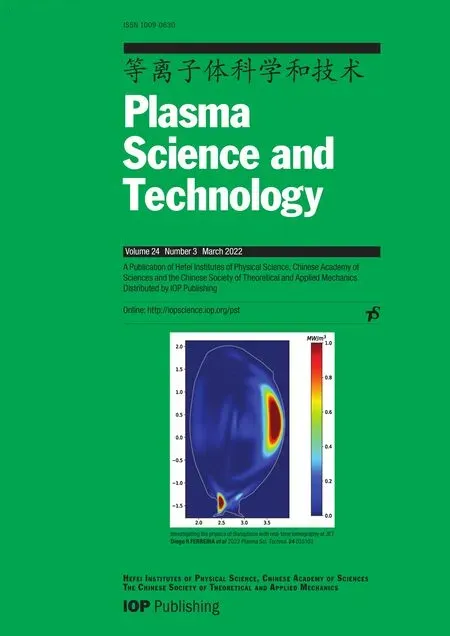 Plasma Science and Technology2022年3期
Plasma Science and Technology2022年3期
- Plasma Science and Technology的其它文章
- Design and preliminary test of a 105/140 GHz dual-frequency MW-level gyrotron
- Competitive effect between roughness and mask pattern on charging phenomena during plasma etching
- A novel flexible plasma array for large-area uniform treatment of an irregular surface
- Pulsed high-current discharge in water:adiabatic model of expanding plasma channel and acoustic wave
- Comparison of double layer in argon helicon plasma and magnetized DC discharge plasma
- Physical design of a new set of high poloidal mode number coils in the EAST tokamak
